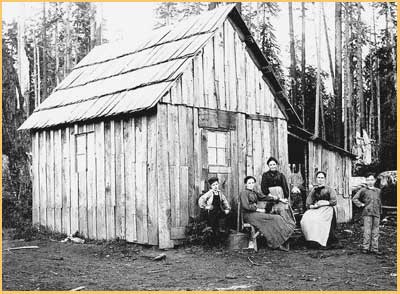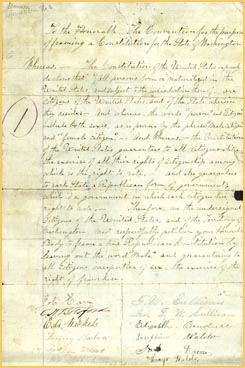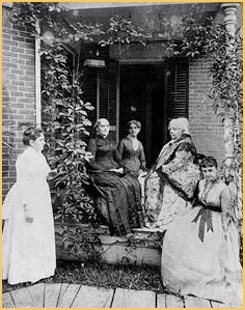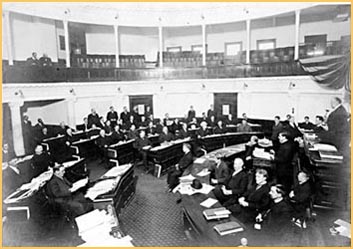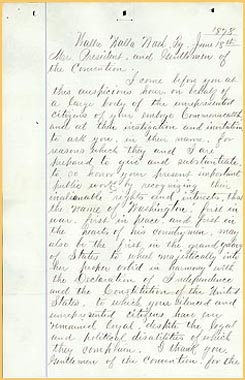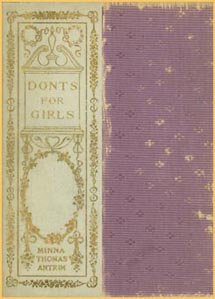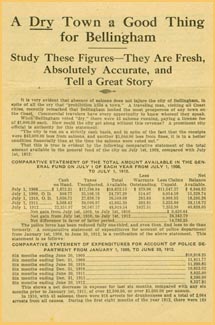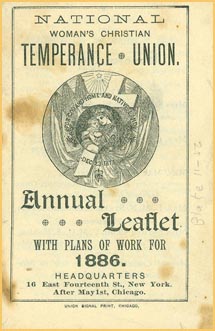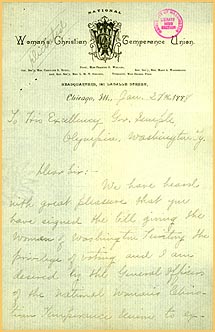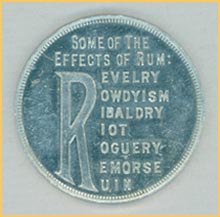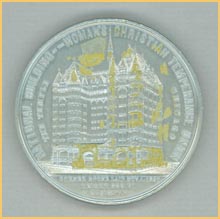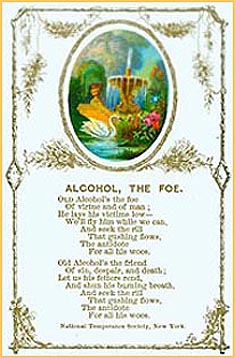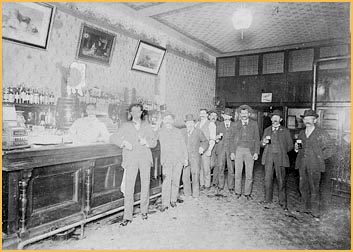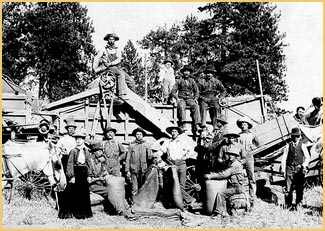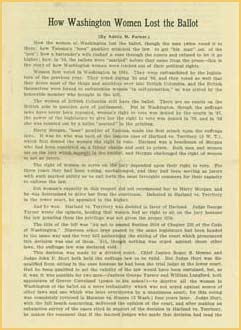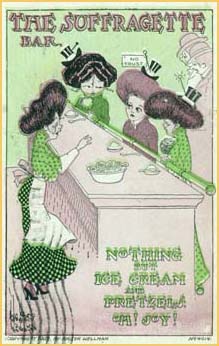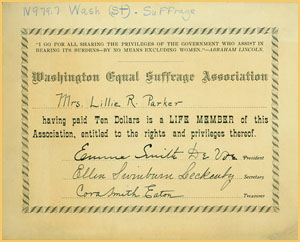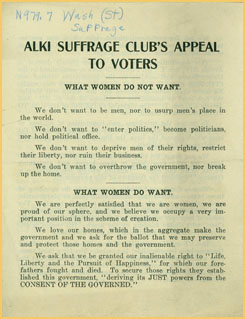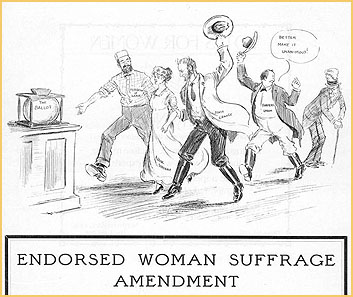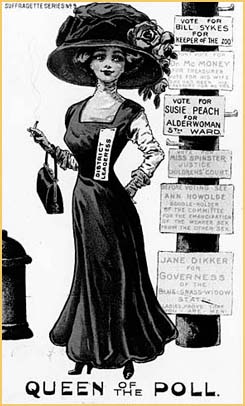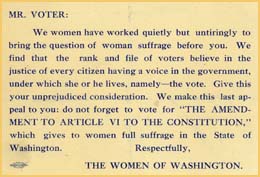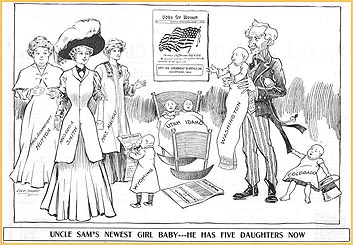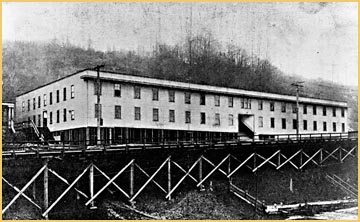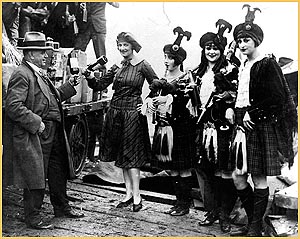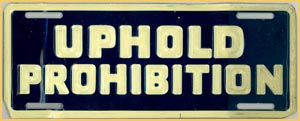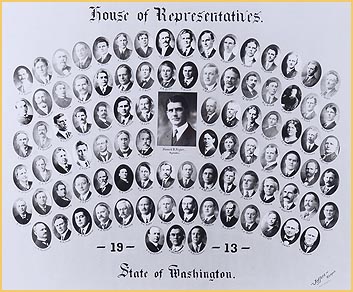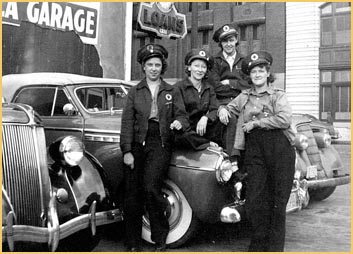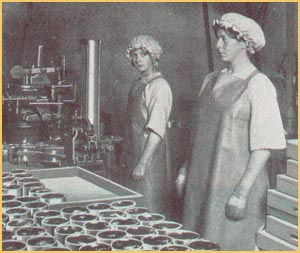In 1776, Abigail Adams asked her husband to "remember the ladies and be more generous and favorable to them than your ancestors." So began the long fight for woman suffrage in the United States, a fight that would span over a century until 1920 when the Nineteenth Amendment was adopted giving women across the country the right to vote.
The 1910 campaign for woman suffrage in Washington State is often seen as a key event in the history of woman suffrage in the United States. As the first state in the twentieth century to grant women the right to vote—and the first state to adopt woman suffrage in almost fifteen years—Washington revitalized the suffrage movement and inspired the national campaign that led to the passage of the Nineteenth Amendment.
Washington women's right to vote was not easily won, however. In a struggle that spanned over 50 years, women wrote petitions, lobbied the legislature, published suffrage newspapers, and delivered speeches. They won the right of franchise several times only to have it taken away each time, but continued to fight for their right to vote as citizens of the United States.
This exhibit celebrates the 100th anniversary of women’s permanent right to vote in Washington State, and the women who worked so diligently to make it happen.
In exchange for the difficult life of a pioneer, women in the West generally had greater rights than their counterparts back East. For example, the federal Oregon Donation Act enacted in 1850 allowed married women to claim half of their husband’s land in their own name; as more and more settlers took advantage of this law, the increase in population allowed Washington to split from Oregon Territory in 1853.
In 1869, the legislature also passed Washington Territory’s first community property law which gave women joint legal ownership of any property purchased by either themselves or their husbands after marriage. Although they may not have realized it, by strengthening the legal status of women, the legislature was laying the groundwork for the woman suffrage movement in the territory.
The first women's rights convention in the nation was held in Seneca Falls, New York in 1848, and resulted in the creation of the Declaration of Sentiments. Inspired by the U.S. Constitution, the Declaration of Sentiments called on the government to grant female citizens "all the rights and privileges" that white American males received. The document was signed by 68 women and 32 men on July 20, 1848.
One of the women who signed the Declaration of Sentiments was Catharine Paine Blaine. When she moved to Seattle in 1853 with her husband David Blaine, a Methodist minister, she brought her ideas about women’s rights with her. Blaine continued to subscribe to political newspapers that addressed issues like women’s rights and the temperance movement, and she opened a community school—Seattle's first—which encouraged female enrollment. During the first term, 13 of the 14 students were girls. She also wrote many letters to her family back east criticizing the injustice of voting laws in Washington Territory.
When Catharine and David Blaine first arrived in Seattle in 1853, they stayed for a short while with Arthur and Mary Ann Boren Denny. Washington had separated from Oregon Territory that year, and Denny had recently been elected to the first territorial house of representatives. There is no evidence to show that Blaine's views on women's rights had an influence on Denny, but at the first meeting of the Washington Territorial Legislature in Olympia in 1854, he proposed that a pending bill on voting be amended to "allow all white females over the age of 18 years to vote." The bill failed by a vote of 8-9.
The voting law that was approved stated that "all white male inhabitants of twenty-one years, of three months' residence, provided they are citizens of the United States, or have declared their intentions to become such" were allowed to vote along with mixed-blood Indian men "who have adopted the customs and habits of civilization." Many women, including Blaine, were upset that men of "lower classes" were allowed to vote while women continued to be denied the right of franchise.
In 1867, Bellingham legislator and woman suffrage supporter Edward Eldridge convinced the territorial legislature to remove the word "male" from the voting laws so that the new law read, "all white American citizens above the age of twenty-one years" have the right to vote. Citing the Fourteenth Amendment to the U.S. Constitution which defines citizens as "all persons born or naturalized in the United States," Washington women concluded that they should be allowed to vote.
Mary Olney Brown, a suffragist from White River, decided to test the law in 1869, but her ballot was rejected despite her arguments that she was a U.S. citizen and therefore allowed to vote. Undeterred, she wrote several articles urging women to vote and convinced her sister, Charlotte Olney French, to launch a suffrage campaign in nearby Grand Mound. French—along with fourteen other women from Grand Mound and nearby Black River—were allowed to cast their votes in the 1870 election, but Brown’s ballot was again rejected. As Brown recalled later, "I was looked upon as a fanatic, and the idea of a woman voting was regarded as an absurdity."
Oregon suffragist Abigail Scott Duniway invited noted national suffragist Susan B. Anthony to tour the Pacific Northwest in 1871. With Duniway acting as tour manager, the two women spent six weeks campaigning in Oregon before journeying to Olympia where they were invited to speak to the territorial legislature in favor of woman suffrage on October 19th. In her speech, Anthony declared that "By all men's definitions of the term, the withholding of the ballot and representation while taxes are imposed is the most abject of servitude." She went on to suggest that the legislature adopt an act "…making it the duty of the judges of election to count [women's] votes, the same as those of the men." Although Anthony’s speech was well received, when her proposed act was introduced the next day, it failed by a vote of 13-11.
At the end of their tour, Anthony and Duniway returned to Olympia for Washington's first women's suffrage convention which began on November 8, 1871. By the end of the convention, the Washington Territory Woman Suffrage Association (WTWSA) had been organized, female officers were elected, and resolutions had been passed. Women in Olympia and Thurston County were inspired to create local suffrage organizations, as well as lobby for woman suffrage during the rest of the 1871 legislative session. In retaliation, the legislators passed an anti-suffrage law which stated that "Hereafter, no female shall have the right of ballot, or vote at any poll or election precinct in this territory until the Congress of the United States of America shall, by direct legislation, declare the same to be the supreme law of the land."
Anthony and Duniway's tour was met with mixed reactions. Prominent citizens such as Sarah Yesler, Reverend Daniel Bagley, territorial legislator Daniel R. Bigelow, and newspaper editor John Miller Murphy were supportive, but the two women also had their fair share of critics.
Churches in Walla Walla refused to host the women because they thought Anthony had accepted a glass of wine from a bartender in Umatilla, Oregon; she spoke in the back room of a Walla Walla saloon instead. Anthony also faced criticism from newspapers throughout the region. She was described as a "most horribly ugly" old maid, and denounced as an infidel who supported free love. Despite these attacks, Duniway felt that the tour was a rousing success and later remembered "…finding friends wherever we went…"
In 1878, the territorial governor called for a constitutional convention to be held in Walla Walla as part of an effort to get Washington admitted as a state. Although the legislature had decided to table the issue of woman suffrage indefinitely in 1871, Olympia suffragist Mary Olney Brown saw the convention as a great opportunity to lobby for a woman suffrage clause in the new constitution. She circulated petitions throughout the territory and also wrote editorials educating men and women about the issue.
Duniway was also allowed to speak at the convention in support of woman suffrage. In her speech, she appealed to the delegates to "Grant to woman her rightful place beside you in the new constitution of the new state, which you are to christen Washington, and forthwith your newborn commonwealth shall become a star of the first magnitude…"
Despite the efforts of Duniway, Brown, and other supporters who lobbied for women’s rights at the convention, the suffrage clause presented to the voters failed. Congress later rejected the constitution along with Washington's bid for statehood, but the anti-suffrage sentiments of the male voters were clearly broadcast to the women of the territory.
Many men and women of this period believed that the proper sphere of womanhood was the home, and that women did not need to vote because nothing beyond their doorsteps was of concern to them. Instead of engaging in public affairs, women were taught to manage households, raise children, and entertain company.
Women who attempted to assert their political identities were often openly criticized. Newspaper accounts of Mary Olney Brown's first attempt to vote in 1869 denounced the idea that "a woman should unsex herself by dabbling in the filthy pool of politics."
Although many women felt that their proper sphere was the home, others believed that women needed the right to vote so they could protect their homes and families from vice and corruption. Taking on the role of moral housekeeper, these women spoke out against slavery, prostitution, gambling, and most of all, alcohol.
The Women’s Christian Temperance Union came to Washington in 1883 and quickly grew — within a year, there were already 629 members in King County alone. The main purpose of the organization was to achieve prohibition by law which the women worked toward by singing hymns and praying in saloons, lobbying for temperance reform, and presenting anti-drinking programs in schools.
Although Abigail Scott Duniway feared that men wouldn't support woman suffrage if women were in favor of prohibition, temperance women continued to be closely allied with the woman suffrage movement.
With the support of farmers from eastern Washington in the legislature, women in Washington finally gained the right to vote in 1883. Anxious to exercise their new right, women across the state voted against corrupt politicians, and voted for local option prohibition. In the 1884 election, a larger percentage of women voted than men, casting 12,000 out of 48,000 ballots. Within a few years, it was estimated that four-fifths of all the women in the territory went to the polls on election day.
Their victory was short-lived, however. In 1887, the right of women to serve on juries was questioned in the case of Harland v. Territory of Washington. The Territorial Supreme Court ruled that women were not legal jurors and revoked the 1883 law because they said the title of the law did not describe its content, making it invalid.
Suffragists united with temperance organizations and labor unions to contest the court's decision, and on January 18, 1888, Governor Eugene Semple reenacted the woman suffrage law. By August 1888, however, the Territorial Supreme Court had again overturned the law.
Suffrage organizations lobbied to reinstate the suffrage law in 1889 during Washington's second Constitutional Convention, and again in 1898, but they continued to be unsuccessful. Some blamed this on the saloon lobby which Seattle suffragist Adella Parker believed had printed fraudulent ballots in the 1889 election. Others pointed to widespread concerns that women would continue to tackle moral issues like gambling and corrupt politicians if given the right to vote. Overall, it was felt that women were just not interested in voting.
Though women's right to vote had been openly contested for many years, there were some things that women were qualified to vote for. Since 1871, women had been allowed to vote in school district elections, and by 1877 they could vote in school board director elections in their local districts. In 1895, the first female superintendent of schools, Ella Guptill, was elected in Clallam County.
Women alone were also invited to vote for the state flower as part of Washington’s display at the 1893 Chicago Columbian Exposition. After a lively campaign and many suggestions including the four-leaf clover, fleur-de-lis, dogwood, syringe, wild rose, marguerite, and Oregon grape, the rhododendron won with 7,704 votes.
It wasn't until 1905 when the National American Woman Suffrage Association held a convention in Portland, Oregon, as part of the Lewis & Clark Centennial Exposition that the suffrage movement in Washington was revived. Several of the women who attended the convention—including Emma Smith DeVoe and Dr. Cora Smith Eaton—brought their suffrage ideals to Washington where they soon began efforts to start a new suffrage campaign.
Working with Spokane suffragist May Arkwright Hutton, DeVoe launched the first stage of her campaign: passage of a suffrage amendment in the legislature. Reform-minded Progressives receptive to woman suffrage dominated the legislature, and DeVoe worked hard to adopt a low-key image so as not to incite any opposition. The amendment she drafted with Senator George Cotterill did not even mention woman suffrage but instead said that it was an amendment "relating to the qualification of the voters within this State."
The amendment passed and was signed by Acting Governor Marion Hay on February 25, 1909, but not before DeVoe and Hutton had a serious falling out over strategies. While DeVoe advocated using a persistent but ladylike technique, Hutton believed that the campaign needed to be more forceful and less polite to be effective. One of DeVoe's allies suggested that Hutton had considered buying the votes of senators, while other suffragists began questioning DeVoe's leadership style.
Following the defeat of the woman suffrage law in 1898, many women lost interest in the issue and suffrage organizations dissolved. Washington women had a strong history of forming women's clubs devoted to individual and community improvement, however, and many of these groups remained intact. In fact, the Woman's Club of Olympia—organized in 1883 and recognized as one of the first study clubs on the West Coast—is still in existence today.
When DeVoe began reorganizing suffrage organizations in 1906 as part of her efforts to revive the suffrage campaign in Washington, she turned to the women's clubs for support. With their assistance, the membership of the Washington Equal Suffrage Association jumped from 2 to 2,000, and by 1908, 75 suffrage organizations had been formed across the state. These suffrage organizations were instrumental in circulating petitions, conducting poll list canvasses, and raising money to support the cause.
Although the amendment had been approved by the legislature, it still had to be ratified by the public in November 1910. In the next twenty months, suffragists actively lobbied the men in their lives, and drew on support from churches, the Grange, labor unions, and the Farmers Union. Temperance organizations also supported the campaign but agreed to keep a low profile so as not to provoke the saloon lobby.
DeVoe also invited the National American Woman Suffrage Association to hold their national convention in Seattle as part of the Alaska Yukon Pacific Exposition. On June 25, 1909, 85 national suffragists left Chicago on a special suffrage train bound for Washington. The convention began on July 1 in downtown Seattle and culminated in "Woman Suffrage Day" at the Exposition on July 7. Famous suffragists such as Henry Blackwell and Harriet Upton delivered speeches and a kite printed with the "Votes for Women" slogan flew over the fairgrounds. That same month, Dr. Cora Smith Eaton planted a flag with the same slogan at the summit of Mt. Rainier.
Despite the success of the convention, DeVoe and Hutton continued to argue. DeVoe's supporters suggested that Hutton had a foul mouth and an unsavory past, while Hutton questioned DeVoe's motives. Deciding to split from the Washington Equal Suffrage Association of which DeVoe was president, Hutton formed her own suffrage group, the Washington Political Equality League in July 1909. Many other suffragists unhappy with DeVoe's leadership left to form their own organizations as well.
Although there had been much opposition to earlier woman suffrage activities in Washington, the 1910 campaign was met with surprisingly little resistance. Eliza Ferry Leary, daughter of the first Washington governor, was selected as a representative of the National Association Opposed to Woman Suffrage, but chose to do nothing in this role. Even the saloon lobby—previously the most outspoken anti-suffrage group in the state—did nothing to target the campaign, although this is probably because they were busy fighting local-option prohibition that year.
One of the few who spoke out against suffrage was Reverend Mark A. Matthews of Seattle's First Presbyterian Church. During one of his sermons, he claimed that "No sir! This country will never adopt female suffrage. If the ballot were extended to the women the star of America's glory would go down immediately, never to rise again."
Unlike the militant techniques employed by suffragists in Great Britain and elsewhere in the United States, Washington women used a "still hunt" strategy which emphasized one-on-one lobbying. Instead of attending rallies and parades, women were encouraged to press the issue of woman suffrage with their husbands, fathers, and brothers.
Organizers also launched a modern media campaign. Women across the state were hired to write news articles about woman suffrage, and the Washington Equal Suffrage Association even launched their own publication, Votes for Women, in October 1909. Edited by Missouri Hanna, each issue included a poster which women were encouraged to hang. Women also spoke at fairs, distributed leaflets, and organized parlor meetings and debates.
With every approach they employed, women continued to emphasize that they were conducting a womanly campaign. They also tried to convince men that they wouldn't abandon their traditional domestic roles if given the right to vote. The Washington Women's Cook Book, a compilation of recipes and articles supporting woman suffrage, was one way in which women tried to do this. As Emma Smith DeVoe noted later, "the book has made us friends among the men."
On November 8, 1910—over twenty years after the Territorial Supreme Court had last taken away Washington women's right to vote—male voters ratified the woman suffrage amendment with a vote of 52,299-29,676. Every county voted in favor of the amendment with support coming from all political parties and across all demographics. Governor Marion E. Hay officially adopted the amendment on November 28, 1910.
Many newspapers downplayed the event and those that did discuss the passage of the woman suffrage amendment generally gave liberal credit to the male voters—an attitude that was usually adopted by the women as well. As May Arkwright Hutton stated later, "I attribute the success of the movement largely to the broad-minded ideas of the men of Washington, who stand for a square deal in all things."
Women promptly began exercising their newly acquired right, voting in the same proportion as men and setting their sights on moral reform. They were instrumental in the recall of Seattle mayor Hiram Gill who was accused of allowing gambling and prostitution to run rampant in the city, and were also influential in the passing of legislation regarding mother’s pensions, the eight-hour workday for women, Prohibition, and the health and morals of children.
Women also served on juries and ran for office. In the first state election after women gained the right to vote, Frances C. Axtell and Nena Jolidon Croake were elected to the House of Representatives, becoming the first women to ever serve in the Washington Legislature. Although they each only served one term, they were soon followed by increasing numbers of women elected to higher office within the state.
The victory in Washington reinvigorated the woman suffrage movement across the country, and within four years, California, Oregon, Kansas, Arizona, Alaska Territory, Montana, and Nevada had all adopted woman suffrage amendments. Women continued to fight for a national amendment and finally, in June 1919, Congress passed the Nineteenth Amendment to the U.S. Constitution granting women the right to vote. After being sent to the states for ratification, the amendment was officially signed into law on August 26, 1920.
Since then, women have seen their role within society expand. No longer expected—or content—to simply tend to the home and raise children, women began taking on typically male roles in the workplace, achieved high levels of public office, and continued speaking up about women's rights. Although the Washington suffragists of 1910 might not have envisioned all the changes that would occur in women's lives during the next 100 years, they would probably be unsurprised. As Abigail Scott Duniway once said, "When women go for their own rights they generally get them."
